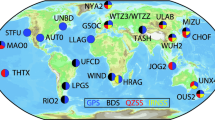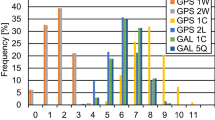Abstract
Conventional GPS processing techniques use the broadcast ephemeris to obtain relative station coordinates. Errors in the broadcast ephemeris can cause baseline errors of the order of 1 ppm. For high order geodetic positioning accuracies, it is therefore necessary to determine precise satellite orbits.
Predicted orbits can be generated by numerically integrating a model of the forces acting on the satellite. Carrier phase data from a number of tracking stations can then be used to improve this predicted orbit. At Nottingham, the phase data is double differenced, and used in a simultaneous least squares adjustment to produce corrections to selected station coordinates and to the predicted orbit.
Access this chapter
Tax calculation will be finalised at checkout
Purchases are for personal use only
Preview
Unable to display preview. Download preview PDF.
Similar content being viewed by others
References
Ashkenazi, V., and Moore, T., 1986. “The Navigation of Navigation Satellites”, Journal of Navigation, Vol 3, No 3.
Fliegel, H.F et al. 1985. “The GPS Radiation Force Model”. Proc. Ist International Symposium on Precise Positioning with the Global Positioning System, Rockville, Maryland
Landau, H., and Hein, G., 1986. “Preliminary Results of a Feasibility Study for a European Tracking Network”. Proc. 4th International Geodetic Symposium on Satellite Positioning, Austin, Texas
Moore, T. 1986. “Satellite Laser Ranging and the determination of Earth Rotation Parameters”. PhD Thesis, Nottingham University.
Author information
Authors and Affiliations
Editor information
Editors and Affiliations
Rights and permissions
Copyright information
© 1990 Springer-Verlag New York Inc.
About this paper
Cite this paper
Ashkenazi, V., Hill, C., Moore, T., Whalley, S. (1990). Orbit Determination for GPS Satellites. In: Bock, Y., Leppard, N. (eds) Global Positioning System: An Overview. International Association of Geodesy Symposia, vol 102. Springer, New York, NY. https://doi.org/10.1007/978-1-4615-7111-7_18
Download citation
DOI: https://doi.org/10.1007/978-1-4615-7111-7_18
Publisher Name: Springer, New York, NY
Print ISBN: 978-0-387-97266-4
Online ISBN: 978-1-4615-7111-7
eBook Packages: Springer Book Archive




